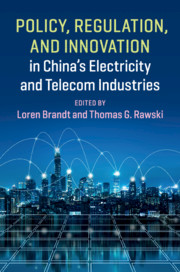Book contents
- Policy, Regulation, and Innovation in China’s Electricity and Telecom Industries
- Policy, Regulation, and Innovation in China’s Electricity and Telecom Industries
- Copyright page
- Contents
- Figures
- Tables
- Contributors
- Acknowledgments
- Abbreviations
- Map of China
- 1 Policy, Regulation, and Innovation in China’s Electricity and Telecom Industries
- 2 China’s Electricity and Communications Regulation in Global Context
- 3 Local Government and Firm Innovation in China’s Clean Energy Sector
- 4 Technology Integration in China’s Electricity System: Central Targets and Local Challenges
- 5 When Global Technology Meets Local Standards
- 6 The Search for High Power in China: State Grid Corporation of China
- 7 Growth, Upgrading, and Limited Catch-Up in China’s Semiconductor Industry
- 8 Growth, Upgrading, and Excess Cost in China’s Electric Power Sector
- 9 China’s Development of Wind and Solar Power
- 10 Capability Upgrading and Catch-Up in Civil Nuclear Power: The Case of China
- Index
- References
4 - Technology Integration in China’s Electricity System: Central Targets and Local Challenges
Published online by Cambridge University Press: 08 June 2019
- Policy, Regulation, and Innovation in China’s Electricity and Telecom Industries
- Policy, Regulation, and Innovation in China’s Electricity and Telecom Industries
- Copyright page
- Contents
- Figures
- Tables
- Contributors
- Acknowledgments
- Abbreviations
- Map of China
- 1 Policy, Regulation, and Innovation in China’s Electricity and Telecom Industries
- 2 China’s Electricity and Communications Regulation in Global Context
- 3 Local Government and Firm Innovation in China’s Clean Energy Sector
- 4 Technology Integration in China’s Electricity System: Central Targets and Local Challenges
- 5 When Global Technology Meets Local Standards
- 6 The Search for High Power in China: State Grid Corporation of China
- 7 Growth, Upgrading, and Limited Catch-Up in China’s Semiconductor Industry
- 8 Growth, Upgrading, and Excess Cost in China’s Electric Power Sector
- 9 China’s Development of Wind and Solar Power
- 10 Capability Upgrading and Catch-Up in Civil Nuclear Power: The Case of China
- Index
- References
Summary
China’s state-directed technology development and deployment programs have led to unprecedented adoption of advanced technologies in its electricity sector. However, signs of inefficient capital allocation are widespread, such as continued coal plant capacity build-out amidst slowing electricity demand growth and underutilization of renewable energy investments. The separation of technology programs from durable local autonomies in electricity systems operation and planning, as well as unsuccessful central reforms to create a market for the fundamental commodity, electricity, contribute to uncaptured economic and public health benefits. China’s programs on high-efficiency coal-fired power plants demonstrate this important lesson for industrial upgrading: technological innovation and adoption do not reap their full benefits without comparable modernization of regulatory and policy frameworks. Ongoing power sector reforms may be insufficient to address these issues.
Keywords
- Type
- Chapter
- Information
- Publisher: Cambridge University PressPrint publication year: 2019
References
- 2
- Cited by

